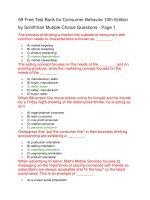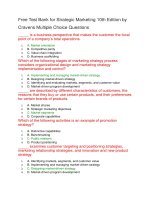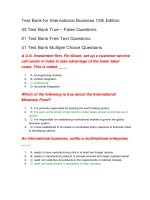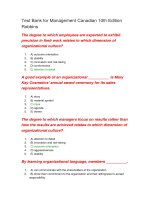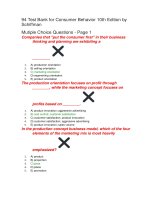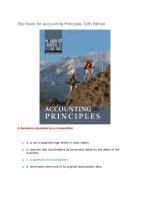120 test bank for management canadian 10th edition robbins
Bạn đang xem bản rút gọn của tài liệu. Xem và tải ngay bản đầy đủ của tài liệu tại đây (170.8 KB, 31 trang )
Test Bank for Management Canadian 10th Edition
Robbins
The degree to which employees are expected to exhibit precision in their
work relates to which dimension of organizational culture?
1.
A) outcome orientation
2.
B) stability
3.
C) innovation and risk-taking
4.
D) conformance
5.
E) attention to detail
A good example of an organizational __________ is Mary Kay Cosmetics'
annual award ceremony for its sales representatives.
1.
A) story
2.
B) material symbol
3.
C) ritual
4.
D) agenda
5.
E) theme
The degree to which managers focus on results rather than how the
results are achieved relates to which dimension of organizational culture?
1.
A) attention to detail
2.
B) innovation and risk-taking
3.
C) outcome orientation
4.
D) aggressiveness
5.
E) stability
By learning organizational language, members __________.
1.
A) can communicate with the shareholders of the organization
2.
B) show their commitment to the organization and their willingness to accept
responsibility
3.
C) attest to their acceptance of the culture and their willingness to help preserve it
4.
D) can share material symbols with other members
5.
E) can provide explanations and legitimacy for current practices
Which type of culture would most likely include characteristics such as
challenge, freedom, idea time, playfulness, and risk-taking?
1.
A) ethical
2.
B) customer-responsive
3.
C) autocratic
4.
D) innovative
5.
E) bureaucratic
An organizational culture most likely to shape high ethical standards is
one that is _________________________.
1.
A) high in risk tolerance, low to moderate in aggressiveness, and focuses on both
means and outcomes
2.
B) low to moderate in risk tolerance, high in aggressiveness, and focuses on both
means and outcomes
3.
C) low in risk tolerance, high in aggressiveness, and focuses primarily on
outcomes
4.
D) high in risk tolerance, high in aggressiveness, and focuses on means rather
than outcomes
5.
E) high in risk tolerance, low in aggressiveness, and focuses primarily on
outcomes
The current dominant assumption in management theory suggests that
________.
1.
A) managers are omnipotent
2.
B) managers are symbolic
3.
C) a balanced view of managers as both symbolic and omnipotent
4.
D) managers are neither symbolic nor omnipotent
5.
E) managers are both dynamic and reflective
Which of the following views of managerial impact is useful in explaining
the high turnover among college/university and professional sports
coaches who are often fired or replaced when their teams perform poorly?
1.
A) symbolic
2.
B) omnipotent
3.
C) reflective
4.
D) interactive
5.
E) dynamic
Elmo Research & Development has been going through a rough patch
lately. Turnover has been high and employee morale is at an all-time low.
Though employees and competitors hold management responsible for the
decline, the CEO does not let the managers go or change the management
style. Which of the following could explain this attitude?
1.
A) The CEO holds the omnipotent view of management, which believes that
external factors have a significant effect on performance outcomes.
2.
B) As the organization has an autocratic management style, the employees are
responsible for organizational policies.
3.
C) The organization has a participative management style and decisions are
guided by consensus.
4.
D) The CEO holds the view that managers have only a limited role in organization
success or failure.
5.
E) The CEO does not have the authority to let the managers go or change the
management style.
The consequences for exceeding one's budget are an example of how
culture may constrain a manager's decision-making options when
performing the function of __________.
1.
A) planning
2.
B) organizing
3.
C) leading
4.
D) controlling
5.
E) coordinating
Which of the following phrases is associated with the definition of
organizational culture?
1.
A) individual response
2.
B) unique vision
3.
C) diversity of thought
4.
D) explicit directions
5.
E) shared meaning
Strong cultures __________.
1.
A) are found in organizations with strong leaders
2.
B) have a minimal influence on employee decision-making
3.
C) exist in all organizations
4.
D) have a greater influence on employees than do weak cultures
5.
E) always yield positive results
Which type of culture would most likely include characteristics such as
friendliness, attentiveness, good listening skills, and widespread
empowerment?
1.
A) ethical
2.
B) customer-responsive
3.
C) autocratic
4.
D) innovative
5.
E) bureaucratic
Most organizations have __________ cultures.
1.
A) very weak
2.
B) weak to moderate
3.
C) moderate
4.
D) moderate to strong
5.
E) very strong
An organization's culture is __________.
1.
A) represented in organizational meetings by the top manager of the organization
2.
B) represented by a common perception held by interest groups that watch the
organization
3.
C) represented by a common perception held by the organization's members
4.
D) changed when the organization is purchased by new owners
5.
E) determined by the nationality of its employees
Internal constraints that restrict a manager's decision options arise from
__________.
1.
A) the organization's environment
2.
B) the activities of industry competitors
3.
C) the rules and policies implemented by top managers
4.
D) the laws and regulations governing workplace practices
5.
E) the organization's culture
What are the two views of managerial impact on the success or failure of
the organization?
1.
A) omnipotent and symbolic
2.
B) omnipotent and reflective
3.
C) symbolic and interactive
4.
D) dynamic and reflective
5.
E) reflective and interactive
Organizational culture is most similar to an individual's __________.
1.
A) skills
2.
B) knowledge
3.
C) motivation
4.
D) ability
5.
E) personality
An organization's specific environment __________.
1.
A) is unique and changes with conditions
2.
B) is the same regardless of the organization's age
3.
C) is determined by the top level of management
4.
5.
D) includes demographic and technological conditions that may affect the
organization
E) includes economic and global conditions that may affect the organization
________ has been described as the shared values, principles, traditions,
and ways of doing things that influence the way an organization's
members act.
1.
A) Corporate hierarchy
2.
B) Business configuration
3.
C) Organization culture
4.
D) Industrial psychology
5.
E) Business culture
Corporate __________ are repetitive sequences of activities that express
and reinforce the values of the organization, what goals are most
important, and which people are most important.
1.
A) languages
2.
B) themes
3.
C) rituals
4.
D) agendas
5.
E) stories
The size of offices, the elegance of furnishings, and executive perks such
as health club memberships are all examples of __________.
1.
A) themes
2.
B) agendas
3.
C) material symbols
4.
D) rituals
5.
E) rewards
The process that adapts employees to the organization's culture is called
__________.
1.
A) indoctrination
2.
B) assimilation
3.
C) socialization
4.
D) infiltration
5.
E) association
The symbolic view of management means __________.
1.
A) managers are directly responsible for an organization's success or failure
2.
B) managers have only a limited effect on organizational outcomes
3.
C) successful managers become role models for employees
4.
D) employees are directly responsible for an organization's success or failure
5.
E) managers are only responsible for those factors that influence organizational
performance
Google has often been cited as a model for employee satisfaction. Google
takes extensive care to ensure employees have the best available
conditions to perform, ranging from free snack bars, free massages,
innovation rooms, spas-on-site, and many more such measures. Which
dimension of organizational culture is Google said to emphasize through
such measures?
1.
A) stability
2.
B) attention to detail
3.
C) aggressiveness
4.
D) people orientation
5.
E) innovation
The degree to which department managers interact with each other is an
example of how culture may constrain a manager's decision-making
options when performing the function of __________.
1.
A) planning
2.
B) organizing
3.
C) leading
4.
D) controlling
5.
E) motivating
The specific environment of organizations consists of external forces that
have a direct impact on managers' decisions and actions. The main forces
are customers, suppliers, competitors, and __________.
1.
A) legislators
2.
B) pressure groups
3.
C) employees
4.
D) lawyers
5.
E) shareholders
The original source of an organization's culture usually __________.
1.
A) is shared among the first workers hired into the organization
2.
B) is formulated by the board of directors when the organization is formed
3.
C) identifies what the organization is successful at doing
4.
D) reflects the vision or mission of the organization's founders
5.
E) can be traced to the national culture of the first organizational members
Managers operate within the internal and external constraints imposed by
__________.
1.
A) federal and provincial governments
2.
B) the employees of the organization
3.
C) the organization's culture and environment
4.
D) the organization's board of directors
5.
E) industry regulation
Sony Corporation's focus on new product development is an example of
which of the following dimensions of organizational culture?
1.
A) attention to detail
2.
B) people orientation
3.
C) outcome orientation
4.
D) aggressiveness
5.
E) stability
The __________ view of management is consistent with the stereotypical
picture of the take-charge business executive who can overcome any
obstacle in carrying out the organization's objectives.
1.
A) dynamic
2.
B) symbolic
3.
C) omnipotent
4.
D) reflective
5.
E) interactive
The omnipotent view of management means __________.
1.
A) the top manager is the only person in charge
2.
B) managers are directly responsible for an organization's success or failure
3.
C) managers are directly responsible for all internal factors within their control
4.
D) managers have little or no responsibility for an organization's success or failure
5.
E) outside forces have the most influence on organizational outcomes
According to the symbolic view, managers have a(n) __________ effect on
substantive organizational outcomes.
1.
A) substantial
2.
B) moderate
3.
C) limited
4.
D) unlimited
5.
E) negative
Despite the existence of both internal and external constraints, managers
can still improve organizational performance by ____________________.
1.
A) delegating more responsibility to employees
2.
B) influencing the organization's culture and environment
3.
C) electing new government officials at the federal and provincial levels
4.
D) redesigning the organization's structure
5.
E) introducing new rules and procedures
According to the textbook, the __________ environment includes those
external forces that have a direct and immediate impact on managers'
decisions and actions and are directly relevant to the achievement of the
organization's goals.
1.
A) general
2.
B) specific
3.
C) secondary
4.
D) forward
5.
E) primary
Which of the following dimensions of organizational culture refers to the
degree to which organizational decisions and actions emphasize
maintaining the status quo?
1.
A) stability
2.
B) attention to detail
3.
C) innovation and risk taking
4.
D) people orientation
5.
E) outcome orientation
Which of the following statements highlights the shared aspect of
culture?
1.
A) Organizational culture is concerned with how members perceive the culture and
describe it, not with whether they like it.
2.
B) Organizational culture is not something that can be physically touched or seen,
but employees perceive it on the basis of what they experience within the
organization.
3.
C) The original source of the culture of an organization reflects the vision of the
organization's founders.
4.
D) Even though individuals may have different backgrounds or work at different
organizational levels, they tend to describe the organization's culture in similar
terms.
5.
E) The dominant source of the culture of an organization reflects the vision of the
organization's most prominent managers.
When employees at Microsoft use words such as: work judo, eating your
own dog food, and flat food, they are using organizational __________.
1.
A) language
2.
B) rituals
3.
C) symbols
4.
D) ceremonies
5.
E) stories
The external environment is made up of which two components?
1.
A) organizational culture and general environment
2.
B) specific environment and general environment
3.
C) primary environment and secondary environment
4.
D) primary environment and general environment
5.
E) national culture and specific environment
Organizational __________ typically contain(s) a narrative of significant
events or people.
1.
A) stories
2.
B) rituals
3.
C) agendas
4.
D) anthems
5.
E) themes
79 Free Test Bank for Management Canadian 10th
Edition Robbins Multiple Choice Questions - Page 2
__________ are any constituencies in the organization's external
environment that are affected by the organization's decisions and actions.
1.
A) Stockholders
2.
B) Pressure groups
3.
C) Suppliers
4.
D) Stakeholders
5.
E) Consumers
As more consumers have become aware of the use of rendered feed and
the poor treatment of chickens in many large-scale poultry farms, some
farm managers have switched to all-natural feed and "free range"
breeding methods. This is an example of how changing __________
conditions can affect an organization.
1.
A) demographic
2.
B) economic
3.
C) socio-cultural
4.
D) technological
5.
E) political/legal
Human resources managers are increasingly using the Internet to search
for qualified candidates through on-line resumé systems and job-posting
websites. This is an example of how changing __________ conditions can
affect an organization.
1.
A) demographic
2.
B) economic
3.
C) socio-cultural
4.
D) technological
5.
E) political/legal
The degree of __________ refers to the number of components in an
organization's environment and the extent of the knowledge that the
organization has about those components.
1.
A) stability
2.
B) flexibility
3.
C) complexity
4.
D) change
5.
E) risk
Interest rates, inflation rates, and stock market indexes are all examples of
what factor in an organization's general environment?
1.
A) economic
2.
B) political
3.
C) socio-cultural
4.
D) technological
5.
E) legal
D&B Designs has been in the landscape design business in Pleasantville
for the past 20years. As the "first mover" in the market, the company has
built a strong market share over the years and is the best-known firm in
the area. The company strength increased steadily, and now stands at 50
employees. Which of the following, if true, would make the company's
business environment more uncertain?
1.
A) Homeowners in the area take pride in their gardens and are avid do-it-yourself
gardeners.
2.
B) Demand for landscaping services dips every autumn and winter.
3.
C) A long-time competitor quit the landscape design business last year.
4.
D) Zoning laws in the area change as each new city council comes into power.
5.
E) A new housing development is being built in town.
Which of the following demographic groups includes individuals who
were born between the years 1946 and 1964?
1.
A) the Depression group
2.
B) the World War II group
3.
C) the Baby Boomers
4.
D) Generation X
5.
E) Generation Y
If the components of an organization's environment change frequently,
the organization is operating in a ________ environment.
1.
A) stable
2.
B) secure
3.
C) dynamic
4.
D) constant
5.
E) complex
The general environment of an organization includes which of the
following?
1.
A) demographic conditions
2.
B) issues directly relevant to achieving organizational goals
3.
C) stakeholders
4.
D) suppliers
5.
E) pressure groups
For an amusement theme park such as Paramount Canada's Wonderland
in Toronto, an insurance provider would be an example of which factor in
their specific environment?
1.
A) competitor
2.
B) customer
3.
C) pressure group
4.
D) government agency
5.
E) supplier
Managers try to minimize __________ because it is a threat to an
organization's effectiveness.
1.
A) product development
2.
B) uncertainty
3.
C) inflation
4.
D) efficiency
5.
E) technology
A downturn in contributions from the public to the United Way charity is
an example of the impact from what factor in its general environment?
1.
A) political
2.
B) socio-cultural
3.
C) technological
4.
D) economic
5.
E) global
For most organizations, the most rapidly changing factor has been
__________ conditions.
1.
A) global
2.
B) economic
3.
C) socio-cultural
4.
D) technological
5.
E) political/legal
The first step of managing external stakeholder relationships is to identify
who the stakeholders are. The second step is to determine __________.
1.
2.
A) how critical each stakeholder is to the organization
B) what the law courts might do when a stakeholder files a claim against the
organization
3.
C) what particular interests or concerns the stakeholders might have
4.
D) how many stakeholders there are in each stakeholder group
5.
E) how to manage the different stakeholder relationships
Which of the following are the two dimensions of environmental
uncertainty?
1.
A) degree of change and degree of complexity
2.
B) degree of change and degree of flexibility
3.
C) degree of complexity and degree of impact
4.
D) degree of impact and degree of uncertainty
5.
E) degree of risk and degree of complexity
The Internet is having an impact on determining who an organization's
competitors are because it has __________.
1.
A) defined the common markets for all industry competitors
2.
B) made the products they sell more valuable to the customer
3.
C) virtually eliminated the need for shopping malls
4.
D) virtually eliminated geographic boundaries
5.
E) made it more difficult for smaller competitors to compete on a global scale
According to the textbook, the members of which one of the following
demographic groups are thinking, learning, creating, shopping, and
playing in fundamentally different ways that are likely to greatly impact
organizations and managers?
1.
A) the Depression group
2.
B) the World War II group
3.
C) the Baby Boomers
4.
D) Generation Y
5.
E) Generation X
When researchers discovered a link between trans fatty acids and heart
disease, many consumers became concerned. As a result, Ontario-based
Voortman's Cookies decided to eliminate all trans fats from its products.
Voortman's was responding to changing __________ conditions.
1.
A) political/legal
2.
B) economic
3.
C) technological
4.
D) socio-cultural
5.
E) competitive
In which of the following environments do managers in an organization
have the greatest influence on organizational outcomes?
1.
A) stable and complex environments
2.
B) dynamic and simple environments
3.
C) stable and simple environments
4.
D) dynamic and complex environments
5.
E) specific and general environments
To a cable television provider such as Shaw Cablesystems, a satellite TV
company such as Bell ExpressVu would be considered a __________.
1.
A) customer
2.
B) supplier
3.
C) pressure group
4.
D) competitor
5.
E) regulator
If the components in an organization's environment change frequently, it
is called a __________ environment.
1.
A) dysfunctional
2.
B) divergent
3.
C) dynamic
4.
D) difficult
5.
E) transitory
As employees have begun to seek more balance in their lives,
organizations have had to adjust by offering family leave policies, more
flexible work hours, and even on-site childcare facilities. This is an
example of how changing __________ conditions can affect an
organization.
1.
A) demographic
2.
B) economic
3.
C) socio-cultural
4.
D) technological
5.
E) political/legal
Which of the following is not an example of a force in the specific
environment?
1.
A) customers
2.
B) demographics
3.
C) suppliers
4.
D) competitors
5.
E) pressure groups
Given a choice, most managers would prefer to operate in environments
that are __________.
1.
A) simple and stable
2.
B) simple and dynamic
3.
C) complex and dynamic
4.
D) complex and stable
5.
E) dynamic and flexible
Which of the following is included in an organization's specific
environment?
1.
A) interest rates
2.
B) government legislation
3.
C) demographics
4.
D) competitors
5.
E) inflation
The Canadian Human Rights Act is an example of a __________.
1.
A) sociolegal condition
2.
B) political/legal condition
3.
C) political/sociological condition
4.
D) socio-cultural condition
5.
E) demographic condition
Which of the following is usually part of an organization's general
environment?
1.
A) weather conditions
2.
B) political conditions
3.
C) competitors
4.
D) suppliers
5.
E) pressure groups
Socio-cultural conditions consist of the __________.
1.
2.
3.
A) demographic profiles of an organization's suppliers
B) laws that govern human rights and the competitive activities of organizations in
a society
C) level of unemployment and real economic incomes of workers
4.
D) changing expectations of the society in which organizations operate
5.
E) socialization processes that help to maintain organizational cultures
Which act makes it illegal for employers to discriminate on the basis of
race, national or ethnic origin, colour, religion, age, sex, marital status,
mental or physical disability, or sexual orientation?
1.
A) Canadian Human Rights Act
2.
B) Canada's Employment Equity Act
3.
C) Canada's Competition Act
4.
D) Canadian Civil Liberties Act
5.
E) Canadian Charter of Rights and Freedoms
The primary goal of managers when dealing with suppliers is to ensure a
steady flow of __________.
1.
A) cash from investors into the organization
2.
B) inputs at the lowest price available
3.
C) customers at the distribution outlets
4.
D) industry entrants to help maximize the competition among suppliers
5.
E) cheap labour to produce products at the lowest possible cost
United Parcel Service represents what factor to Canada Post in its specific
environment?
1.
A) competitor
2.
B) supplier
3.
C) customer
4.
D) government agency
5.
E) pressure group
According to our textbook, __________ is having an impact on
determining an organization's competitors because it has virtually
eliminated geographic boundaries.
1.
A) local area network
2.
B) the intranet
3.
C) the Internet
4.
D) video conferencing
5.
E) government legislation
Which of the following statements concerning the specific and general
environments of an organization is most accurate?
1.
A) Changes in the general environment usually have less impact than changes in
the specific environment.
2.
B) Changes in the specific environment usually have less impact than changes in
the general environment.
3.
C) Changes in both environments usually have an equal impact on the
organization.
4.
D) Changes in either environment usually have little impact on the organization.
5.
E) Changes in either environment usually have more impact than changes in the
organization's culture.
For an organization such as a hospital that needs nurses, the labour union
and the local labour market are examples of which factors in their specific
environment?
1.
A) pressure group and supplier
2.
B) customer and special-interest group
3.
C) both are examples of suppliers
4.
D) government agency and competitor
5.
E) pressure group and competitor
Economic conditions include all of the following factors except
__________.
1.
A) federal government legislation
2.
B) interest rates
3.
C) changes in disposable income
4.
D) stock market fluctuations
5.
E) inflation
Neighbourhood activists who protest against the building of "big box"
stores would be considered which factor in the specific environment for
Wal-Mart or Home Depot?
1.
A) competitor
2.
B) pressure group
3.
C) customer
4.
D) government agency
5.
E) supplier
The enhanced speed and quality of managerial decision-making due to
improvements in office automation is an example of the impact of which
general environmental factor?
1.
A) global
2.
B) socio-cultural
3.
C) political
4.
D) technological
5.
E) demographic
Since the emergence of digital music formats, the recorded music
industry has been operating in an environment that is best described as
__________.
1.
A) stable
2.
B) static
3.
C) dynamic
4.
D) flexible
5.
E) divergent
Political/legal conditions in Canada include all of the following factors
except __________.
1.
A) human rights
2.
B) interest rates
3.
C) employment equity
4.
D) the competition bureau
5.
E) egg marketing boards
36 Free Test Bank for Management Canadian 10th
Edition Robbins True - False Questions
Organizational culture is a perception, not a reality.
1.
True
2.
False
The process that adapts employees to the organization's culture is called
assimilation.
1.
True
2.
False
